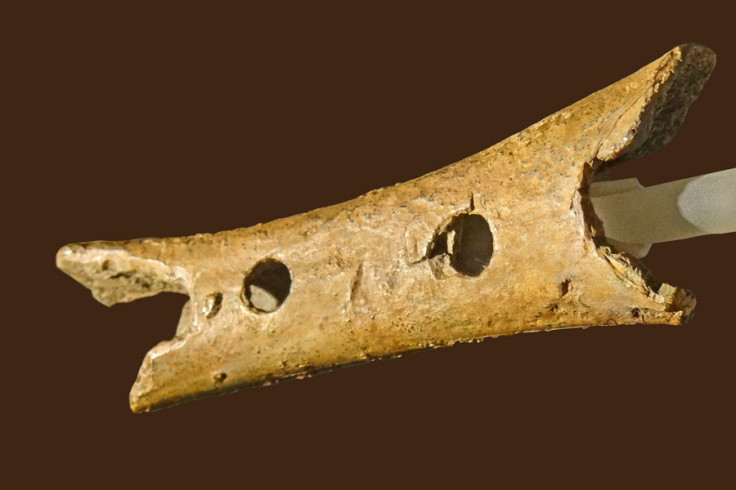Neanderthal 'bone flute' musical instruments were actually hyenas gnawing bear cubs

Neanderthal "bone flutes", once thought to be the earliest examples of musical instruments, are actually the product of hyenas chewing on bear cubs, scientists have said.
In a study published in the journal Royal Society Open Science, Cajus Diedrich, from Paleo-Logic Independent Institute of Geosciences, said these punctured cave bear femora have long been misidentified in south-eastern Europe as the "oldest Neanderthal instruments".
But this is not the case. Instead, he said they are the products of hyenas. Analysis of their teeth marks show the bone flutes are simply the result of the cub bone not breaking when the hyenas gnawed on them.
In most dens or caves identified, about 20% of adults and 80% of bear cub remains have large carnivore damage, Diedrich said. Analysis showed that where the adult bones were "fully crushed to pieces", the bear cubs showed intermediate damage patterns.
"Hyenas produced round-oval puncture marks in cub femora only by both, upper and lower jaw of the bone crushing premolar teeth," he wrote. "The punctures/tooth mark impact marks are often present on both sides of the shaft of cave bear cub femora and are simply a result due to non-breakage of the slightly calcified shaft compacta."
The first bone flutes were found in the 1920s in Slovenia, with examples also appearing in Hungary's Istallosko Cave. Researchers soon started to publish reports, providing proof of the oldest instruments in the world.
Later evidence said the holes appeared not to line up, with another hole declared the "thumb hole" and that there are "exact musical studies" showing a diatonic scale sequence. Musicians went on to create "cave bear bone instruments" based on the holes in the bones.
In his study, Diedrich shows the carnivore damage was created by hyenas – and that this is true of all "afore published 'pseudo bone flutes". He also notes the "Neanderthal" title is incorrect – instead, they came from modern human Aurignacian occupations in entrances of cave beard dens, or deeper inside from hunting.
Researchers analysed several cave bear dens and found damage by lions, hyenas and wolves in all of the larger dens.
Analysis of the bite marks of the bone flutes were identified as being the upper and lower jaw tooth marks of hyenas.
Concluding, Diedrich wrote: "The 'cave bear cub femorae with holes', are, in all cases, neither instruments nor human made at all. All cave bear pseudo-bone flutes are not dated to Neanderthal Middle Palaeolithic Mousterian layers, but instead, if possible to date, to Late Palaeolithic, Aurignacian/Gravettian layers.
"Cub bones are 'soft' and thin-walled in the bone shaft compacta, which increases in subadults and adults. This explains why puncture marks are found only in cub femora... whereas they are absent completely in adults, because hyenas cracked those bones into pieces with the premolar triangle teeth for access to the bone marrow ... Hyenas left, therefore, 'pseudo bone flutes' during the Late Middle to Late Pleistocene all over Europe in cave bear dens."
© Copyright IBTimes 2024. All rights reserved.























